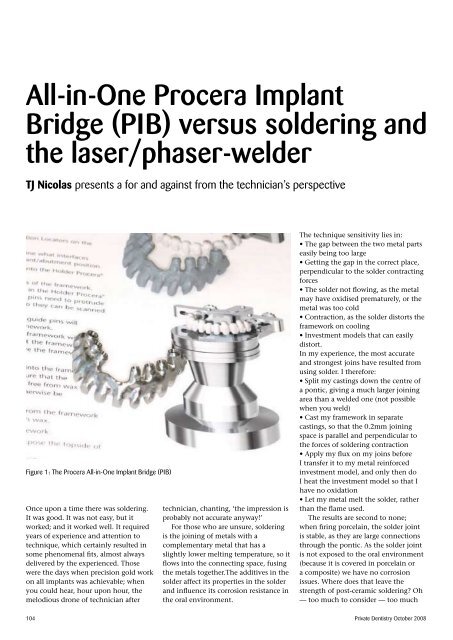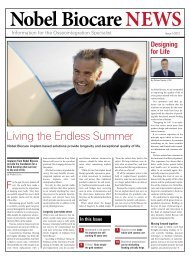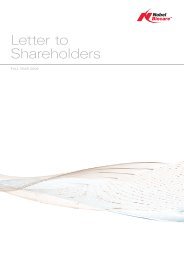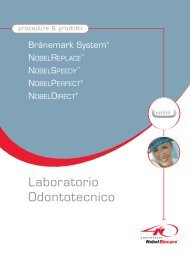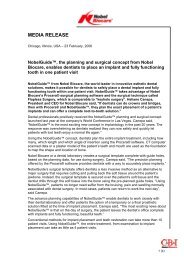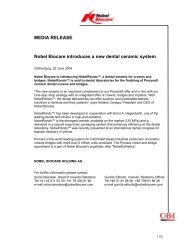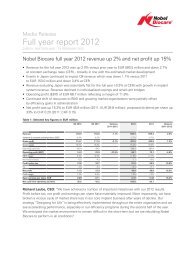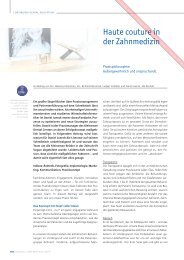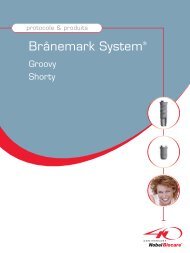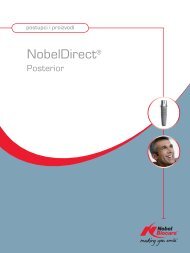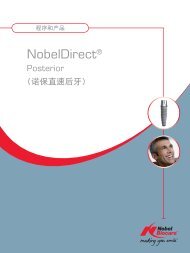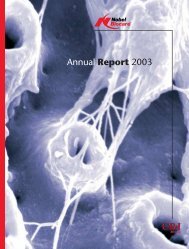All-in-One Procera Implant Bridge (PIB) versus ... - Nobel Biocare
All-in-One Procera Implant Bridge (PIB) versus ... - Nobel Biocare
All-in-One Procera Implant Bridge (PIB) versus ... - Nobel Biocare
Create successful ePaper yourself
Turn your PDF publications into a flip-book with our unique Google optimized e-Paper software.
<strong>All</strong>-<strong>in</strong>-<strong>One</strong> <strong>Procera</strong> <strong>Implant</strong><br />
<strong>Bridge</strong> (<strong>PIB</strong>) <strong>versus</strong> solder<strong>in</strong>g and<br />
the laser/phaser-welder<br />
TJ Nicolas presents a for and aga<strong>in</strong>st from the technician’s perspective<br />
Figure 1: The <strong>Procera</strong> <strong>All</strong>-<strong>in</strong>-<strong>One</strong> <strong>Implant</strong> <strong>Bridge</strong> (<strong>PIB</strong>)<br />
Once upon a time there was solder<strong>in</strong>g.<br />
It was good. It was not easy, but it<br />
worked; and it worked well. It required<br />
years of experience and attention to<br />
technique, which certa<strong>in</strong>ly resulted <strong>in</strong><br />
some phenomenal fits, almost always<br />
delivered by the experienced. Those<br />
were the days when precision gold work<br />
on all implants was achievable; when<br />
you could hear, hour upon hour, the<br />
melodious drone of technician after<br />
technician, chant<strong>in</strong>g, ‘the impression is<br />
probably not accurate anyway!’<br />
For those who are unsure, solder<strong>in</strong>g<br />
is the jo<strong>in</strong><strong>in</strong>g of metals with a<br />
complementary metal that has a<br />
slightly lower melt<strong>in</strong>g temperature, so it<br />
flows <strong>in</strong>to the connect<strong>in</strong>g space, fus<strong>in</strong>g<br />
the metals together.The additives <strong>in</strong> the<br />
solder affect its properties <strong>in</strong> the solder<br />
and <strong>in</strong>fluence its corrosion resistance <strong>in</strong><br />
the oral environment.<br />
The technique sensitivity lies <strong>in</strong>:<br />
• The gap between the two metal parts<br />
easily be<strong>in</strong>g too large<br />
• Gett<strong>in</strong>g the gap <strong>in</strong> the correct place,<br />
perpendicular to the solder contract<strong>in</strong>g<br />
forces<br />
• The solder not flow<strong>in</strong>g, as the metal<br />
may have oxidised prematurely, or the<br />
metal was too cold<br />
• Contraction, as the solder distorts the<br />
framework on cool<strong>in</strong>g<br />
• Investment models that can easily<br />
distort.<br />
In my experience, the most accurate<br />
and strongest jo<strong>in</strong>s have resulted from<br />
us<strong>in</strong>g solder. I therefore:<br />
• Split my cast<strong>in</strong>gs down the centre of<br />
a pontic, giv<strong>in</strong>g a much larger jo<strong>in</strong><strong>in</strong>g<br />
area than a welded one (not possible<br />
when you weld)<br />
• Cast my framework <strong>in</strong> separate<br />
cast<strong>in</strong>gs, so that the 0.2mm jo<strong>in</strong><strong>in</strong>g<br />
space is parallel and perpendicular to<br />
the forces of solder<strong>in</strong>g contraction<br />
• Apply my flux on my jo<strong>in</strong>s before<br />
I transfer it to my metal re<strong>in</strong>forced<br />
<strong>in</strong>vestment model, and only then do<br />
I heat the <strong>in</strong>vestment model so that I<br />
have no oxidation<br />
• Let my metal melt the solder, rather<br />
than the flame used.<br />
The results are second to none;<br />
when fir<strong>in</strong>g porcela<strong>in</strong>, the solder jo<strong>in</strong>t<br />
is stable, as they are large connections<br />
through the pontic. As the solder jo<strong>in</strong>t<br />
is not exposed to the oral environment<br />
(because it is covered <strong>in</strong> porcela<strong>in</strong> or<br />
a composite) we have no corrosion<br />
issues. Where does that leave the<br />
strength of post-ceramic solder<strong>in</strong>g? Oh<br />
— too much to consider — too much<br />
104 Private Dentistry October 2008
Materials and equipment<br />
Figure 2: Three implant level fits at 20 times magnification of a 14-unit seven implant <strong>PIB</strong><br />
responsibility — just tell me what to do!<br />
I can hear the crunch of pliers, the<br />
bang of a hammer, all to deliver yet<br />
another passive substructure. After all<br />
this, Wirz et al concluded, ‘Soldered<br />
jo<strong>in</strong>ts are described as hav<strong>in</strong>g a clear<br />
reduction <strong>in</strong> corrosion resistance, not<br />
to mention tissue irritation.’ (And so<br />
will lead to fracture, due to elements<br />
<strong>in</strong> solders that help to reduce the<br />
temperature.) At the time, it was all we<br />
had, and it still has its place <strong>in</strong> modern<br />
dentistry today.<br />
Technicians lived, and technicians<br />
retired and died. There were those<br />
who could solder <strong>in</strong> this way and<br />
who thought it was good. There were<br />
those who were not so good at it and<br />
who looked for other ways, so that<br />
they didn’t have to do it any more.<br />
Treatment plans changed, as did<br />
techniques; and so the seed was sown.<br />
These were difficult times for those who<br />
knew not how.<br />
The birth of laser-weld<strong>in</strong>g<br />
Then came the birth of ‘titanium’ <strong>in</strong><br />
everyday dentistry. Now, not only could<br />
the <strong>in</strong>attentive and under-tra<strong>in</strong>ed not<br />
solder, but neither could the skilled!<br />
The race was on to solve the titanium<br />
solder<strong>in</strong>g problem. In a flash, ‘laserweld<strong>in</strong>g’<br />
followed, heal<strong>in</strong>g all wounds.<br />
An <strong>in</strong>tense heat source heats just the<br />
area that needs melt<strong>in</strong>g together to the<br />
maximum depth of 1.5mm (an average<br />
connecter on a bridge should be 3mm).<br />
Technicians were happy aga<strong>in</strong> because:<br />
• There were no more <strong>in</strong>vestment<br />
models<br />
• It was direct on the model<br />
• There was no more flux<br />
• It was quick.<br />
Although it is always unrealistic to<br />
expect perfection, I was surprised when<br />
I read a recent article on laser/phaserweld<strong>in</strong>g,<br />
(Lighten<strong>in</strong>g <strong>in</strong> a Bottle by<br />
Joachim Mosch, Andreas Hoffman and<br />
Michael Hopp), <strong>in</strong> which they make<br />
the assertion that, ‘This development<br />
can actually be considered one of the<br />
major breakthroughs (advancements) <strong>in</strong><br />
dental technology <strong>in</strong> the last 15 years.’<br />
They go on to say:<br />
• ‘Proper welded jo<strong>in</strong>ts will lead to a<br />
perfect passive fit’<br />
• ‘Consequently, the surface condition<br />
of the components to be welded (highly<br />
polished or sandblasted) will <strong>in</strong>fluence<br />
the effect of the laser energy. The<br />
sh<strong>in</strong>ier the surface the less effective the<br />
laser will be, as more of the light energy<br />
hitt<strong>in</strong>g the object will be reflected away,<br />
reduc<strong>in</strong>g the ‘melt<strong>in</strong>g’ effect’<br />
• ‘Laser-welders typically need service<br />
and ma<strong>in</strong>tenance once a year, and a<br />
new laser lamp, every three years’<br />
• ‘In a laser-welder, the argon gas needs<br />
to be adjusted almost every time before<br />
weld<strong>in</strong>g, and the position of the nozzle<br />
is often <strong>in</strong> the technician’s way’<br />
• ‘The energy needed to penetrate the<br />
1.5mm would overheat the alloy’<br />
• ‘Practically, distortion must also be<br />
considered. To avoid distortion dur<strong>in</strong>g<br />
the weld<strong>in</strong>g process, place the spots<br />
carefully’<br />
• ‘The bent bar at the top prevents<br />
distortion’.<br />
I stopped read<strong>in</strong>g at this po<strong>in</strong>t<br />
because it seemed to me that the<br />
overwhelm<strong>in</strong>g evidence po<strong>in</strong>ted to<br />
the fact that to produce a passive,<br />
complicated implant <strong>in</strong>tegral structure<br />
is but a dream. I personally saw a laserwelded<br />
implant bridge, where one of<br />
the fixtures was shy of the implant<br />
replica by 0.5mm. For me, laser-weld<strong>in</strong>g<br />
is not the answer. It can do th<strong>in</strong>gs that<br />
conventional solder<strong>in</strong>g sometimes<br />
cannot do, but it is still only as good as<br />
the technician who is us<strong>in</strong>g it. There is<br />
still a ‘melt<strong>in</strong>g pool’ contraction at the<br />
site of melt<strong>in</strong>g the metals. Depend<strong>in</strong>g<br />
on the user, and us<strong>in</strong>g conventional<br />
solder<strong>in</strong>g, this can be larger than a<br />
precision-soldered jo<strong>in</strong> at 0.2mm.<br />
After study<strong>in</strong>g articles, and try<strong>in</strong>g the<br />
process myself, I f<strong>in</strong>d laser-weld<strong>in</strong>g has<br />
more applications than conventional<br />
solder<strong>in</strong>g, but I do th<strong>in</strong>k that <strong>in</strong><br />
conventional work, when repair<strong>in</strong>g<br />
holes <strong>in</strong> cast<strong>in</strong>gs, the time taken to<br />
re-wax and add the new unit <strong>in</strong>to the<br />
Private Dentistry October 2008 105
‘I can now f<strong>in</strong>alise my substructure <strong>in</strong> the lab and start to be creative with much<br />
more freedom and expression than ever before. I can fire my titanium porcela<strong>in</strong><br />
onto some <strong>PIB</strong>s and I can use Gradia composites on others. I am mak<strong>in</strong>g s<strong>in</strong>gle<br />
unit substructures through to full arches, and they can be made <strong>in</strong> zirconia as well<br />
as <strong>in</strong> titanium.’<br />
next cast<strong>in</strong>g r<strong>in</strong>g is more accurate and<br />
less time-consum<strong>in</strong>g. In bridge cases,<br />
where the metal needs actually to<br />
touch on another at the weld<strong>in</strong>g jo<strong>in</strong>,<br />
it will require a much higher level of<br />
skill than conventional solder<strong>in</strong>g <strong>in</strong><br />
order to ensure that, by add<strong>in</strong>g and<br />
subtract<strong>in</strong>g to the jo<strong>in</strong>, it touches<br />
exactly. <strong>All</strong> that sounds troublesome<br />
and time-consum<strong>in</strong>g to me. But there<br />
aga<strong>in</strong>, laser-weld<strong>in</strong>g does have its place,<br />
because it is one of the only methods<br />
that work with titanium. And even<br />
now, with experience born out of 12<br />
years of marriage, a little voice is say<strong>in</strong>g<br />
<strong>in</strong> my head, ‘Be constructive; do not<br />
just criticise.’<br />
We knew it all along<br />
So there it was all along, the answer<br />
right from the beg<strong>in</strong>n<strong>in</strong>g. As<br />
technicians, we all do it every day and<br />
all the time, on nearly every cop<strong>in</strong>g<br />
we make. We mill it and trim it. No<br />
solder<strong>in</strong>g or weld<strong>in</strong>g <strong>in</strong> any shape,<br />
way or form. No heat expansion or<br />
contraction, no gaps to fill, no flux to<br />
contam<strong>in</strong>ate, no technique-sensitive<br />
prelim<strong>in</strong>ary procedures, no material<br />
cost. Just hours and hours of mill<strong>in</strong>g<br />
and cutt<strong>in</strong>g, until our f<strong>in</strong>gers fall off<br />
and we jo<strong>in</strong> the exhausted heap of<br />
solderers and laser-welders of time<br />
gone by.<br />
I am sorry and afraid that my story<br />
is not over yet! I have been over-see<strong>in</strong>g<br />
this method by us<strong>in</strong>g cad-cam and a<br />
mill<strong>in</strong>g mach<strong>in</strong>e <strong>in</strong> the construction of<br />
passive units, us<strong>in</strong>g the <strong>Procera</strong> <strong>All</strong>-<strong>in</strong>-<br />
<strong>One</strong> system for the last four years. (In<br />
an attempt to save my f<strong>in</strong>gers and it<br />
is so easy.) Yet, it does not seem to be<br />
part of our everyday rout<strong>in</strong>e <strong>in</strong> every<br />
laboratory and dental practice. It is<br />
be<strong>in</strong>g challenged by other less accurate<br />
products on the market. Why doesn’t<br />
anyone seem to be talk<strong>in</strong>g about it? So<br />
I wondered; am I miss<strong>in</strong>g out on the<br />
miracle of laser-weld<strong>in</strong>g? Might I need<br />
to buy one?<br />
I used the Noble <strong>Biocare</strong> open tray<br />
technique, <strong>in</strong> which screw-reta<strong>in</strong>ed<br />
impression cop<strong>in</strong>gs are connected<br />
and duralayed to one another, and<br />
a viscous, hard-bodied accurate<br />
impression material is <strong>in</strong>jected<br />
<strong>in</strong>to a custom-made tray. In this<br />
impression, the soft tissue solid model<br />
is poured, and on this a diagnostic<br />
try-<strong>in</strong> is created, us<strong>in</strong>g metal temporary<br />
cyl<strong>in</strong>ders that are connected together<br />
<strong>in</strong> acrylic. I then f<strong>in</strong>ish the framework<br />
<strong>in</strong> acrylic and Sweden does the rest. My<br />
reward is an engag<strong>in</strong>g (s<strong>in</strong>gle-units),<br />
non-engag<strong>in</strong>g zirconia or titanium, all<strong>in</strong>-one<br />
milled structure that fits. And,<br />
boy does it fit!<br />
This fit (see Figure 2) is due to its<br />
unsurpassed ability to contact-measure<br />
simple, pure, implant replicas of given<br />
dimensions, and then laser-scann<strong>in</strong>g<br />
the external framework, which does not<br />
need the accuracy of contact-scann<strong>in</strong>g.<br />
Together this arithmetical equation<br />
is re-enacted with mill<strong>in</strong>g tools,<br />
transform<strong>in</strong>g a solid homogeneous<br />
titanium block <strong>in</strong>to dentistry at its best.<br />
I welcome this form of technology <strong>in</strong><br />
my profession. It ensures for the patient<br />
what would be unachievable by man.<br />
I can now f<strong>in</strong>alise my substructure<br />
<strong>in</strong> the lab and start to be creative with<br />
much more freedom and expression<br />
than ever before. I can fire my titanium<br />
porcela<strong>in</strong> onto some <strong>PIB</strong>s and I can<br />
use Gradia composites on others. I<br />
am mak<strong>in</strong>g s<strong>in</strong>gle unit substructures<br />
through to full arches, and they can<br />
be made <strong>in</strong> zirconia as well as <strong>in</strong><br />
titanium. The only limitation with<br />
this phenomenal product is that, with<br />
screw-reta<strong>in</strong>ed substructures, you are<br />
unable to deviate more than 20 degrees<br />
from the implant screw-hole open<strong>in</strong>g.<br />
(You can also use the multi-unit<br />
abutment for Noble <strong>Biocare</strong> implants<br />
that can correct an axial alignment of<br />
the implant for the desired position<strong>in</strong>g<br />
of the screw-channel, etc — the list<br />
goes on.)<br />
We are, however, able to work<br />
around most implants’ head-placement,<br />
as implants at bone level mean that the<br />
po<strong>in</strong>t of rotation allows for a marked<br />
relocat<strong>in</strong>g potential of the access hole.<br />
This deviation, <strong>in</strong> measure, is about<br />
7mm at 2cm from axis of rotation.<br />
The access-hole is smaller than some<br />
rivals, as the screwdriver access is the<br />
thickness of the screw-head, rather<br />
than the screwdriver used. Us<strong>in</strong>g a<br />
composite case, if you want the screw<br />
to be <strong>in</strong>tegral <strong>in</strong> the framework, the<br />
hole is much more discreet because the<br />
screwdriver shaft is only 1.5mm thick.<br />
What I like most about the <strong>PIB</strong><br />
method is the freedom of aesthetics.<br />
It is, at last, a solution that I would<br />
use <strong>in</strong> my own mouth <strong>in</strong>stead of a<br />
denture. As a technician for 20 years,<br />
I have always ma<strong>in</strong>ta<strong>in</strong>ed that the<br />
aesthetics of full arch implants and<br />
their emergence profiles with long<br />
root effects do noth<strong>in</strong>g for me. Some<br />
dentists say, ‘It does not matter what’s<br />
under your lip because you cannot see<br />
it.’ I suspect that many patients, given<br />
the choice, would actually have exist<strong>in</strong>g<br />
work redone for better tissue aesthetics.<br />
We have the materials and we have<br />
the skills. <strong>All</strong> we need to do is educate<br />
dentists, technicians and patients, and<br />
encourage them to use it.<br />
<strong>PIB</strong> benefits<br />
The advantages of <strong>PIB</strong>s are manifold.<br />
106 Private Dentistry October 2008
They:<br />
• Have a passive accurate fit, perfect to<br />
the model implant analogs<br />
• Have the best aesthetic potential on<br />
the market<br />
• At implant level are 40% cheaper than<br />
traditional methods to date, as the parts<br />
are <strong>in</strong>cluded <strong>in</strong> the prosthesis<br />
• Have no more yellow gold and other<br />
potential metal allergies<br />
• Are made <strong>in</strong> the same metal as the<br />
implants themselves (no galvanic<br />
potential)<br />
• Are capable of more comb<strong>in</strong>ations of<br />
reconstructive solutions over any other<br />
product on the market<br />
• Are able to move access channel-holes<br />
to enhance the aesthetic result<br />
• Can be covered with conventional<br />
crown and bridge work<br />
Can be made <strong>in</strong>:<br />
• <strong>Procera</strong> <strong>Implant</strong> <strong>Bridge</strong> Zirconia (now<br />
up to 14 units)<br />
• <strong>Procera</strong> <strong>Implant</strong> <strong>Bridge</strong> Titanium<br />
• <strong>Procera</strong> <strong>Implant</strong> <strong>Bridge</strong> Titanium for<br />
other implant systems<br />
• Camlog, Astra Tech and Ankylos<br />
• Enabled through a new Multi-<br />
Unit Abutment (the new Multi-Unit<br />
Abutment fits with the follow<strong>in</strong>g<br />
implant systems: Camlog 3.3, 3.8, 4.3,<br />
5.0, 6.0; AstraTech 3.5ST, 4.0ST, 4.5ST,<br />
5.0ST; Ankylos 3.5, 4.5, 5.5, 7.0)<br />
• Can be used with a wider range of<br />
implant systems<br />
• Already fits Straumann Regular Neck<br />
4.8mm and Wide Neck 6.5mm.<br />
To sum up<br />
<strong>PIB</strong>s tick all the criteria <strong>in</strong> modern<br />
dentistry, both functionally and<br />
aesthetically, and their longevity record<br />
is good. Requir<strong>in</strong>g yearly ma<strong>in</strong>tenance,<br />
they are easy to clean, simple to<br />
repair, cost-effective and aesthetically<br />
predictable. Every time one is sent<br />
to me, I am amazed at the fit; and I<br />
th<strong>in</strong>k that, <strong>in</strong> the future, they may<br />
well prove to be a primary tool <strong>in</strong> our<br />
profession, just as the primary colours<br />
are the foundation of all colours <strong>in</strong><br />
the ra<strong>in</strong>bow. As I try on yet another<br />
framework, and look under my 20 times<br />
magnification, I marvel that the miracle<br />
has happened aga<strong>in</strong>. No more wait<strong>in</strong>g<br />
for the answer; simply a feel<strong>in</strong>g of great<br />
thankfulness, as I look back to the good<br />
old days and remember when I tried to<br />
solder or laser-weld that large case for<br />
Mrs Maxilla, and how long it took.<br />
And the next step? Stem cell<br />
technologies, successful, predictable,<br />
soft tissue and bone grafts? What an<br />
excit<strong>in</strong>g thought! And what good news<br />
for the patient — who must always be<br />
our first consideration. PD<br />
Comments to pd@fmc.co.uk<br />
TJ Nicolas, RDT NHD RSA is w<strong>in</strong>ner of<br />
dental technician of the year 2007-2008.<br />
Private Dentistry October 2008 107


